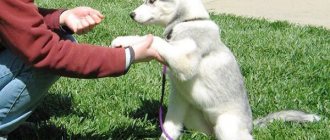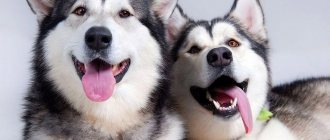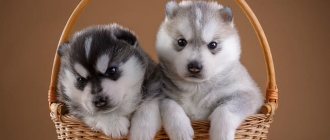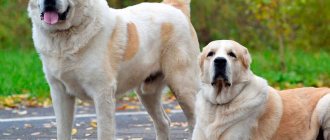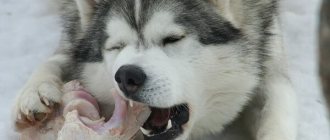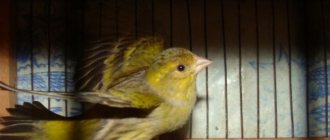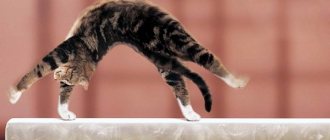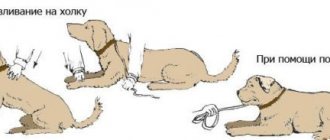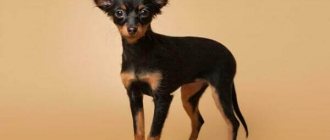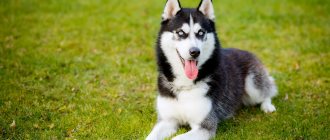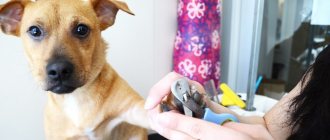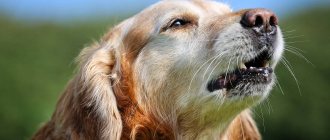Close relatives of huskies are wolves, so the breed is very different in temperament from other dogs: they are stubborn and willful and are in no hurry to listen to people.
Huskies are not suitable for weak-willed and lazy people; a dog should be raised and trained by a person with high leadership qualities.
Only a person with a tough and confident hand can tame their temper and wean them from bad habits.
But well-mannered huskies are friendly and affectionate pets that will not cause trouble to the owner and members of his family.
Character and behavior
These dogs are distinguished by their peacefulness and friendliness. They enjoy the company of dogs, people, and the attention of their owner and family. However, like all northern breeds, they are prone to dominance, willfulness and stubbornness. Huskies prefer to be free, although they unquestioningly obey the owner who can prove his leadership.
Animals are very active and need constant training. If the pet does not splash out energy, then it becomes destructive. In the family they behave like perky family dogs, always ready to help. They treat their owner with trepidation and cannot tolerate long separations.
No contact
Not gonna get us!
The most important reason. The owner can adore his dog, humanize it, treat it like a child. Through the “rose-colored glasses” of love, it is not visible that the pet does not reciprocate. For example, an owner, while walking a pet, constantly says something to it, tries to give commands, but the animal does not turn its head. Let's keep silent about the dog following commands.
If you let such a pet off the leash (or he breaks off it on his own), either scream or not - don’t call. Why should a dog return to someone with whom he is not interested, when suddenly new horizons and spaces have opened up? The dog will run off to explore the world, that’s all.
Attitude towards children
Even in the far north, it was customary to get a Husky when a baby was born in the house. It was believed that every child should have a dog.
The animals not only served as working dogs. They were nannies, toys, hot water bottles. In severe frosts, all the pets were gathered in a room to keep the children warm.
Huskies treat children of different ages with trepidation, play with them, and take care of them. They will protect babies from danger. The dog is considered a family dog, so it is suitable even for couples with newborns . Any angry or aggressive behavior is not observed among representatives of the breed.
Health
The average life expectancy of a husky is 12 years.
When properly bred, these are very healthy dogs, but, like any breed, they have their “weak points”: dysplasia and cataracts. The correct selection of breeding pairs allows you to minimize the risk, however, unfortunately, not all breeders work correctly. The situation is aggravated by the fact that huskies have become fashionable, and the demand for them is very high, which means there is a huge temptation and ample opportunities for unscrupulous breeders. Carefully study the Husky breed standard before purchasing.
It’s good if parents have marks about testing their parents for genetic diseases, but this is still rare in Belarus.
How to choose a husky puppy?
When choosing a puppy, pay attention to the reputation of the breeder. If possible, meet those who have already taken puppies from this nursery - how happy they are.
Find out what vaccinations you have received. But keep in mind that a puppy up to 3 months cannot receive all vaccinations - vaccination cannot begin earlier than 45 days and sometimes takes up to 5 months. So if you are adopting a younger puppy, the remaining vaccinations will be your responsibility.
Breeder's recommendation: Assess the condition of the parents. The saying “the apple doesn’t fall far from the tree” is also true when it comes to dogs. If you are greeted by 7 adorable babies, but the mother looks exhausted and unhealthy, a miracle will not happen.
If you take a puppy without documents, it's basically a Pandora's box. Perhaps these are not huskies at all, but mestizos. The pedigree gives you at least a guarantee that this is a purebred puppy. Yes, it does not guarantee victories at the World Championships, but at least you will get the breed you paid for.
The puppy should be well-fed, active, and without a bloated belly.
Pay attention to the content. The room should be clean and there should be no unpleasant odor. A self-respecting breeder will never allow the dog’s “house” to stink or for the puppies to live in dirt.
Be sure to draw up a purchase and sale agreement with the breeder.
Relationship with the owner
A dog can have different relationships with its owner:
- The most common and correct model is the leadership of the owner and the obedience of the pet. If the Husky understands that a person is a leader, then he will obey him. This can be achieved through long-term training.
- Another acceptable model of relationships is fraternal. When the dog and the owner live and work on equal terms: they share food, bed, house, work together, performing their functions. Then the pet will consider the person an equal and obey him as a partner.
Two wrong parenting options: an idol dog and a rad dog. In the first case, the family exalts the pet over its own needs, which is why the Husky becomes uncontrollable. In the second, the animal is abused, which destroys its psyche.
Content
- The main character traits of Siberian Huskies: female or male?
- Character of Siberian Huskies
- Basic commands
- Raising a dog
In this article you will learn what features of character and behavior are inherent in Siberian Huskies. After studying this information about the temperament and disposition of Siberian Huskies at different ages, you will get an idea about the breed. Find out how the character of a bitch differs from the behavior of a dog. We hope our article will help you figure out which gender of puppy is best for you.
How do dogs get along with cats?
A husky can get along with cats only if they grow up together from childhood . They are even able to make friends. Otherwise, certain problems will arise, although with proper upbringing the dog will restrain its hunting instincts.
Due to the fact that dogs are pack animals, they are accustomed to living off their own feeding. Their habit of killing small animals for survival has still not been eliminated.
Behavior with other pets
All fur-bearing animals, birds, and livestock can become the object of sudden hunting. Huskies love to track game for food. Therefore, it is better not to keep this dog and other pets in the same house. If the dog lives on a farm, then all animals must be well fenced.
Cost of training classes
Training with a dog handler is not cheap. But if you can’t handle the dog on your own, the training isn’t going well, then it’s worth spending the money.
The price of the lesson depends on the conditions: there are individual lessons on the territory of the canine center, joint with other dogs, and individual lessons with a dog handler visiting your home (the most expensive).
Also, the price of the course depends on the region of residence. In small cities, the cost of a lesson averages from 500 to 1000 rubles, in large cities – from 1000 and above.
Theoretical knowledge is not enough for training to bear fruit. In any case, you need to consult with a dog handler and introduce him to the dog. Each animal is individual, and education is also carried out individually. Only with experience can you train an obedient and controllable husky.
Strangers and Huskies
Due to its excessive friendliness, the breed cannot serve as a guard or simply protect property. Huskies do not consider strangers dangerous because they are used to being in the company of people and helping them.
As puppies, dogs adore everyone they see. They strive to get to know the whole world. Adult pets become more reserved, a little indifferent to people, and can be wary. However, any traits of aggressive behavior are considered unacceptable for this breed. Cases of outbursts of anger are very rare.
Good or evil?
This is one of the few dog breeds whose representatives are absolutely not characterized by aggressive behavior.
Huskies are friendly towards everyone and will even prefer to make friends with strangers and strangers, which, in fact, makes them poor guards and watchmen..
A certain degree of aggression is possible only in relation to other people's cats, which these dogs perceive as objects of hunting, and neighboring dogs, to whom husky boys strive to demonstrate their superiority.
Dog habits
Habits can be physiological, age-related or psychological:
- So, for example, during the period of changing teeth, you can notice your pet’s desire to try everything “to the teeth.”
- Another physiological bad habit is swallowing large pieces when receiving food . This is due to the fact that the animal tends to slow down its metabolism in order to stay full longer.
- Age-related habits include eating feces, stones, and branches. During the period of active growth, the puppy needs many useful microelements. With their deficiency, the pet tries the surrounding objects, getting used to their consumption.
- Another unpleasant feature is the tendency of male dogs to mark corners. This is due to the desire to show that the territory belongs to a certain pet. Simple education will help avoid this.
- Huskies love to dig holes. They can make digs or simply destroy flowerbeds for fun. They like to wallow in the ground and snow, and dig through garbage. During puppyhood, dogs are considered especially destructive.
- Despite the fact that the breed is classified as “quiet” (non-barking), one of the problems is howling. Most often, dogs whine out of boredom or to attract attention. This can be attributed to psychological habits.
Characteristics of puppies
Each puppy is unique, but breeders conditionally divide all puppies into three classes:
- Pet class - puppies without pedigree; have any non-critical defects that exclude their participation in exhibitions.
- Breeding class - puppies of this class will be allowed for breeding in the future; representatives that meet all breed standards.
- Show class - puppies of titled parents with excellent pedigree that meet all breed standards.
Newborns
As a rule, newborn Siberian Huskies weigh from 350 to 500 g. Weight varies depending on the number of puppies in the litter, as well as the gender of the newborn.
In appearance, newborn huskies are no fundamentally different from most newborns of other breeds.
The eyes are closed, the paws are thick, the coat is predominantly white, but with distinctive spots of various colors. It is somewhat more interesting to observe the development of the puppy further, month by month:
- 1 month . Already 15 days after birth, the weight of babies increases more than three times. They are actively developing and by the end of the month reach up to 24 cm at the withers, and up to 3700 g in weight.
- 2 months . By this period of a husky’s life, it is already perfectly built and moves well. The ears begin to rise. He gains weight well, on average 7500 g with a height of 32 cm.
- 3 months . A transfer is made to five meals a day, as a result of which the pet’s accelerated growth rate continues. Height at the withers is about 40 cm.
- 4 months . The transition to adolescence occurs, the features of an adult dog begin to emerge, all this happens simultaneously with rapid growth in height (46 cm) and weight gain, the husky already weighs 18 kg.
- 5 months . Lines continue to form. Gains weight up to 23 kg and height up to 50 cm.
- 6 months . Already a large (under 25 kg) and tall dog (height at the withers is about 54 cm). But still, he is still far from becoming an adult.
- 7 months . There are even fewer distinctive features from an adult representative of the breed. He gains an average of about 3 kg in weight, and may not gain any height at all.
- 8 months . Sexually mature individual. Growth is slowing down. Weight is approaching 30 kg, and height can reach 58 cm.
- 9 months . The height at the withers is 58 cm - this is the height of an adult dog. Weight can reach 33 kg.
- 10 months . With proper care and proper care, by the age of ten months a husky puppy will gain 35 kg, which is the average norm for an adult. It no longer grows in height.
- 1 year . The weight of a male dog can increase up to 40 kg due to accompanying factors. Can grow up to 60 cm in height (but unlikely unless it reaches this mark at 10 months).
Table of weight, height and size by month
| Husky puppy age by months | boy (cm) | Girl (cm) | Weight, kg | ||
| Height at withers | On the back | Height at withers | On the back | ||
| 1 month | — | — | 2,7 | ||
| 2 months | 32 | 30 | 5,9 | ||
| 3 months | 42 | 40 | 10,5 | ||
| 4 months | 484 | 50 | 47 | 50 | 14,3 |
| 5 months | 53 | 54 | 51 | 52,5 | 19,5 |
| 6 months | 55 | 57 | 53 | 54 | 21,5 |
| 7 months | 57 | 58 | 55 | 55 | 24,3 |
| 8 months | 58 | 59,5 | 56 | 56,5 | 25,5 |
| 9 months | 59 | 60 | 57 | 57,5 | 26,5 |
| 12 months | 60 | 62 | 58 | 59 | 28 |
IMPORTANT! The data presented in the table has an average value. Small deviations from these values are allowed.
When do puppies' eyes open?
It happens differently for each puppy; it is impossible to predict the date of opening of the eyes down to the minute. In a properly developing dog, the eyes open 11–16 days after birth. Only one or half of both may open, maybe both entirely. It will take a few more days for the baby to be able to see fully, like an adult dog. If a month has already passed since birth and the eyes are not open, you should contact a veterinarian.
REFERENCE. Two weeks after birth, the puppy can be helped to open its eyes with boiled water.
When does eye color change?
Most Huskies are born with blue eyes, but within six months some of them may change eye color. The Husky breed is also characterized by odd eyes.
To what age do they grow?
The Husky is a large dog, and like most large dogs, it takes a long time to develop. From birth to six months, development in boys and girls is almost identical, after which some differences arise.
- Girls . The phase of active development is up to 8 months, growth continues up to 1 year and is finally formed by 2 years.
- Boys . They actively grow up to 9 months, development occurs up to 1.5 years, and formation occurs up to 2.3 years.
When do teeth change?
They are born without teeth and develop a full set of milk teeth by three months. Then the milk ones begin to gradually fall out and permanent ones appear in their place, this happens until the seventh month. By the ninth month, the puppy should have all 42 permanent teeth.
Advantages of the breed
The owner determines the merits for himself, because all dogs are individual and differ in character. The main advantages of the breed are highlighted:
- Friendliness, positivity, affability;
- Openness, sociability, contact;
- Good intellectual abilities;
- Good relationships with relatives;
- Huskies rarely bark;
- There is no specific dog smell;
- Not aggressive;
- Mobility (remain active until old age);
- Dogs do not need large amounts of food;
- Strong immunity, endurance to cold and work.
Disadvantages and difficulties
Breed disadvantages include:
- Stubbornness and willfulness (like all northern dogs, Huskies love freedom, although they are used to living side by side with humans);
- Tendency to dominate in the family (the breed is a sledding breed, its representatives have worked for centuries in a pack, where it is important to show leadership qualities in order to become a leader);
- Tendency to run away (vagrancy is one of the main disadvantages of northern hunting and sled dogs);
- Strong hunting instinct (any bird or small animal in the eyes of a Husky is prey);
- Intolerance of loneliness (the pet constantly needs human attention);
- Dogs love to dig and chew;
- The need for high physical activity;
- Twice heavy molting (in spring and autumn);
- The breed is not suitable for beginners and requires training;
- Not suitable for security.
Behavior in the house and apartment
Pets are fussy in enclosed spaces . They can get used to life in the city, but there should be plenty of indoor space. The activity of the breed can be considered a disadvantage, especially if walks are rare and short. The animal will run, chew and damage objects, and howl. This can be weaned off in childhood, although the basis of good behavior is regular physical activity.
Huskies can be annoying and demand attention. If the dog is often left alone, it will become sad, lose interest in life, or become completely uncontrollable.
Behavior in the yard of a private house
If a Husky lives on the street, then he must be provided with the necessary conditions: a comfortable kennel or enclosure with a strong fence, a high fence, a place for running and active games.
Pets are accustomed to living in cold climates, so frosts will not frighten them, which cannot be said about heat. They like to wallow in the ground, snow, flower beds, and garbage. Therefore, it is worth protecting dangerous or expensive objects.
- Dogs are overly curious and often run away by jumping over the fence. Plus, they love to dig. To protect your pet, the exit should be lined with hard tiles, and for digging, organize a special place with a mountain of sand or soft earth.
- If livestock and poultry are kept nearby, the demarcation of the territory should be strong and high. These dogs mistake chickens and geese for prey. If they collide with a cow or horse, they may be trampled.
- One way or another, Husky will like this kind of life, even in an enclosure. Because in free conditions they can frolic as much as they want. A pet living on the street also needs less stress.
Preference for natural products
At the stage of selecting a competent diet, it is important to pay attention that dishes must contain proteins, fats, and dietary fiber, which are necessary for the normal functioning of the gastrointestinal tract. They must be enriched with amino acids, as well as all necessary vitamin complexes.
Products for preference:
Meat protein
Good meat is the main basis of protein for a pet, so its amount in the diet should be at least 80 percent. It is better to give preference to dietary types. This is chicken and turkey meat. It is more rational to avoid fatty pork and lamb. However, due to enhanced absorption of food, the body quickly digests fatty meat with minimal stress on the internal organs. But it is better to introduce pork as an exception. In addition, it is harmful, because it is often sold of poor quality and infected with viruses.
Internal organs of slaughter animals
It is a combination of all edible organs. The maximum percentage of biologically significant elements is concentrated in the liver, lungs, and heart. In addition, for dogs under one year old it is better to buy beef tripe. By-products should be present in the diet every day, but do not overdo it, because the dog may encounter an overabundance of organic compounds.
Bones
The pet should not eat them; it is useful for him to simply gnaw on the massive bones, because this helps cleanse and strengthen bone tissue.
Cartilage
They are distinguished by the maximum concentration of fibrillar protein, which is important for the development of the skeleton and muscles. The simultaneous consumption of meat and cartilage is allowed.
Cereals
Huskies can eat only three types of cereals: oatmeal, buckwheat, rice. Cereals should be present in your pet's daily diet because nutritious fiber and fiber help improve the functioning of the gastrointestinal tract. Their amount should be up to ten percent of the diet.
Fish
It is allowed to consume only marine varieties that contain the necessary amino acids. Iodine, phosphorus, and fluorine are important for your pet, so it is recommended to feed him fish at least twice every 7 days.
Sour milk and cottage cheese
They contain a high concentration of calcium, which is important for the growth of bone and muscle fibers. It is allowed to add exclusively low-fat fermented milk products to the diet. This refers to biokefir (0%) and cottage cheese (minimum fat content). They are served fresh, especially biokefir (maximum three days). Cottage cheese or kefir is used to replace one lunch, usually in the morning.
Eggs
From chicken, you can give only the yolk, or buy quail, they are given whole.
Vegetables
They are a storehouse of important micro and macroelements. A head of cabbage is especially rich in vitamins; it normalizes the functioning of the gastrointestinal tract. Tomatoes are good for bone tissue. Do not neglect carrots, zucchini, pumpkin, and legumes.
Vitamin complexes
They should be purchased after consultation with a veterinarian. List of prohibited products:
- pure milk;
- chicken egg white;
- tubular bones;
- chocolate, cocoa beans;
- grapes, pure or dried;
- potato;
- nuts, other allergens;
- pure sugar and its substitutes;
- vitamin complexes that are not intended for animals;
- smoked meats, marinades, pickles, fried or spicy foods;
- products with the maximum percentage of preservatives and additives;
- hot or cold drinks.
How should dishes be prepared?
The meat is served pure and pre-frozen for 72 hours. Then it is cut into large pieces; it is forbidden to grind it into minced meat. Seafood is pre-boiled. Soft-bone varieties can be served raw, but must be defrosted before doing so.
The cereals are not boiled, simply brewed with hot water and left to infuse for up to half an hour. You can add a drop of oil. Salt is allowed. Pepper and other flavoring additives are prohibited.
The eggs are served boiled, after which the whites are removed. Quail eggs can be given raw or boiled.
Vegetables are not suitable when cooked, but it is better to get rid of raw ones. They need to be steamed. Vegetables are placed in hot water for 20 seconds or in the steam compartment of a multicooker. Peeled tomatoes or cucumbers can be served uncooked.
The offal is washed in several waters and boiled for up to two hours. They can concentrate parasites that die when treated with high temperatures.
Behavior on the street
The dogs are very sociable, they love the company of their relatives, the puppies strive to sniff and play with everyone they meet. Males often run away when they smell a female. The owner must accustom the pet to the fact that it is always more interesting to be with a person. To do this, while playing with other animals, the owner needs to periodically call the puppy, give him treats, and concentrate his attention on communicating with the family.
In general, outdoor animals are active, playful and curious . They will not phlegmatically stroll around their owner; they need to study everything and get to know everyone. Huskies can chase cats and pigeons, although otherwise they react calmly to objects: they rarely bark and do not run after bicycles or cars.
During the winter season, pets love to play in the snow and even often sleep in snowdrifts. In the summer, they won’t refuse to swim in a pond or pool.
Low activity
Hurray, I'm walking!
When a pet is taken out for a walk twice a day, for ten minutes, it accumulates a huge amount of energy. Some dogs, trying to throw it out, begin to destroy the house. Others become extremely hysterical, and still others, seizing the moment while walking, run away from their owners.
Some dogs may not wait until they are let off the leash, but simply break it off and go explore the world around them. This is usually done by very large dogs, whose owner is not always able to physically hold the pet due to his size.
Features of walking without a leash
The breed is northern, bred for persistent hard work, transporting goods and people over long distances. Therefore, when going outside, the animal feels free. Huskies love to run a lot and for a long time, they are curious and rarely obedient, so they often get lost and run away. A weak and slow person will not be able to hold and later catch up with the dog. Many owners keep their pets off a leash to avoid such situations, although this breed needs free runs.
Very often, city authorities prohibit walking medium and large dogs without muzzles and leashes. In this case, the pet must be taken outside the populated area: to the river, to the landing, to the lake, avoiding public crowded places.
Dog handlers recommend teaching your Husky a leash from the first walks and not letting him go in urban environments until he is completely submissive, where the dog can get lost or get hit by a car. The animal needs to know all the commands and be able to carry them out under any conditions. Although this breed is difficult to train to obedience.
Command training
Training is mandatory; it is not enough to simply educate a dog so that it understands how to behave. Following commands and obedience will make living together between an animal and a person more comfortable for both parties.
To me
The “Come to me” command should be one of the first to teach your husky. Using this command, you can call the dog to you on the street, preventing it from escaping or meeting strangers.
It is better to start training at home. When the puppy is playing or lying in his place, look at him, call him by name, and say “Come to me!”, patting him on the leg.
Repeat until the dog comes, praise and encourage. Next, when the dog confidently follows the command at home, repeat it outside.
If the dog refuses to approach, do not approach yourself, do not swear. We must constantly prove our leadership.
Near
A dog on a walk begins to overtake, walks to the side or lags behind, pull the leash so that the husky is at your leg. Say “Here” and give the treat while holding your hand near your leg. Repeat the command as necessary, in the future you will no longer need to pull the leash, the pet will remember the instructions.
Voice
Teaching a Husky the “Voice” command is very simple. Put a leash on the dog, step on it so that the dog cannot move away. Hold the treat in your hand, show it to the puppy and say “Voice” (sharply and loudly). The husky will not be able to reach it and will start barking. Give the treat and praise.
Sit
Approach your husky with a treat in your hand and call him by name to get his attention. Say “Sit” by holding the treat above his head and using your other hand to gently press down on his sacrum. The dog will sit down. Praise, treat.
Place
Huskies need to be raised from day one, and the “Place” command is learned first. The dog is given a bed: clean, dry and soft. Toys are laid out on it to make it more interesting for the dog.
Lay the puppy down, pet him, and walk away after a while. the puppy will want to go too, you must strictly say “Place”, he will stop and sit down.
Lie
There are several ways to teach a Husky the “Lie Down” command, here are the simplest types of training:
- Give the command “Sit” by pressing on the sacrum. Slowly lower the treat down to the ground, saying “Lie down.” The puppy will settle down, praise him, give him a treat.
- Approach the dog, place one hand behind its front legs, and place the other on the withers. Say “Lie down,” lightly press on the withers, and with your other hand, pull up the paws so that the dog begins to lie down. Praise, treat.
It is forbidden
You can teach a husky to stop doing dirty tricks, taking things that are not meant for her, or picking up trash with the command “No”.
They pronounce it strictly, pulling the dog by the collar or leash away from what attracted its attention.
Ugh
Training to follow a command is the same as training the command “No”. You need to choose one of the two so as not to confuse the dog.
Who is the breed not suitable for?
- These pets are characterized by increased activity . They need to train a lot, walk, play. Therefore, Husky is not suitable for homebodies, sedentary people and elderly people.
- In addition, dogs are strong and fast. In case of escape, an unhealthy person will not be able to catch up with an animal that has not been trained in commands.
- Also, puppies need to be trained for a long time and persistently, accustoming them to the rules of behavior, walking and feeding regime . If the family is not prepared for the fact that at first the dog will not be obedient, neat and restrained, then getting a Husky is not recommended.
Even a teenager can work with representatives of the breed, because they learn quickly and easily. But the dog is best suited to an avid dog breeder who has already kept northern Laikas or similar pets. Although a beginner can practice his training skills with these doggies.
OKD
It is recommended to begin the general training course from the age of 3 months, although some send their ward for training from 2 months - it depends on the personal qualities of the dog.
You can start training at 4 months, but it is not recommended to delay it too much, since training will be more difficult, and it is almost impossible to train an adult dog.
